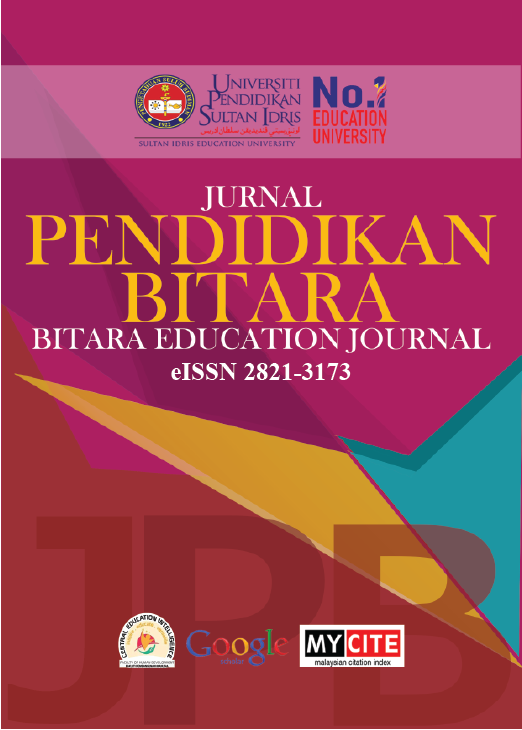Hearing impaired student achievement on the bahasa melayu subject : are these tests applicable?
DOI:
https://doi.org/10.37134/bitara.vol12.7.2019Keywords:
Bahasa Melayu, Hearing Impaired, Hand Signal, LanguageAbstract
Hearing impairment is an area within special education. It is also one of the factors contributing to difficulty in learning at schools for children. Some students are also unable to communicate effectively with teachers. Linguistically, hearing impaired children are already having a tough time understanding the Malay subject, before adding on the two different hand codes. This study utilizes a quantitative descriptive research design where data was gathered from five schools in Malaysia, from different states. It would analyze hearing impaired student Bahasa Melayu achievement obtained from the five schools ranging from year 1 to year 6. The tests were divided into 2 sections which are comprehension and writing. Findings indicated that students did worse in their writing section compared to the comprehension section for both the mean and median analysis.
Downloads
References
Elliot, J. L., & Thurlow, M. L. (2006). Improving test performance of students with disabilities: On district and state assessments (2nd ed.). Thousand Oaks: CA: Corwin Press.
Francisco, A. A., Groen,, M. A., Jesse, A., & McQueen, J. M. (2017). Beyond the usual cognitive suspects: The importance of speechreading and audiovisual temporal sensitivity in reading ability. Journal of Learning and Individual Differences, 54, 60-72.
McQueen, J. M. (2017). Beyond the usual cognitive suspects: The importance of speechreading and audiovisual temporal sensitivity in reading ability. Journal of Learning and Individual Differences, 54, 60-72.
Grove, N., & Woll, B. (2017). Assessing language skills in adult key word signers with intellectual disabilities: Insights from sign linguistics. Journal of Research in Developmental Disabilities, 62, 174-183.
Hallahan, D. P., Kauffman, J. M., & Pullen, P. C. (2011). Exceptional Learners: An Introduction to Special Education (12th Edition) 12th Edition. Virginia: Pearson Education.
Hashim, S., Razali, M., & Jantan, R. (2007). Psikologi pendidikan. Kuala Lumpur: PTS Publication & Distributor Sdn. Bhd.
Holmer, E., Heimann, M., & Rudner, M. (2016). Evidence of an association between sign language phonological awareness and word reading in deaf and hard-of-hearing children. Research in Developmental Disabilities, 48, 145-159
Humphries, T., Kushalnagar, P., Mathur, G., Napoli, D. J., Padden, C., Rathmann, C., & Smith, S. (2016). Avoiding linguistic neglect of deaf children. Social Service Review, 90(4), 589-619.
Marschark, M., Leigh, G., Sapere, P., Burnham, D., Stinson, C. C. M., Knoors, H., Vervloed, M. P. J., & Noble, W. (2006). Benefits of sign language interpreting and text alternatives for deaf students’ classroom learning. Journal of Deaf Studies and Deaf Education, 11, 421-437.
Marschark, M., Shaver, D. M., Nagle, K. M., & Newman, L. A. (2015). Predicting the academic achievement of deaf and hard-of-hearing students from individual, household, communication, and educational factors. Except Child, 81(3), 350–369.
Ministry of Education (2012). Dasar Pendidikan Kebangsaan. Putrajaya: Giga Wise Network.
Mohd Salleh, N., Serajul, H. F., Mohd Ali, M., & Bari, S. (2001). Pendidikan khas di Malaysia: Kepelbagaian pengajaran dan pembelajaran. Prosiding seminar pendidikan khas kebangsaan. Universiti Kebangsaan Malaysia.
Nuttaya, I, Surachai, S, & Wacheerapan, K. (2011). The Learning Achievement in Thai Language for Hearing Impaired Students in Thailand. US-China Education Review, 7, 1023-1029.
Potocki, A. , Sanchez, M., Ecalle, J., & Magnan, A. (2015). Linguistic and Cognitive Profiles of 8- to 15-Year-Old Children With Specific Reading Comprehension Difficulties: The Role of Executive Functions. Journal of Learning Disabilities, 50(2), 128-142.
Trussell, J. W., & Easterbrooks, S. R. (2017). Morphological Knowledge and Students Who Are Deaf or Hard-of-Hearing: A Review of the Literature. Communication Disorders Quarterly, 38(2), 67-77.
Tee, C. T. (1970). Special Education in Malaysia. Jurnal Kementerian Pelajaran Malaysia, 95-98.
Werts, M. G., Culatta, R. A., & Tompkins, J. R. (2006). Fundamentals of Special Education: What Every Teacher Needs to Know (3rd Edition). Pearson; 3rd edition edition.
Wilbur, R. (2013). Changing How We Think About Sign Language. Gesture and Agreement. Sign Language and Linguistics,. 16(2), 221-258.
Wilbur, R. (2013). Changing how we think about sign language, gesture, and agreement. Sign Language Syntax from a Formal Perspective: Selected Papers from the 2012 Warsaw FEAST, 221-258. Retrieved 6 20, 2019, from https://doi.org/10.1075/sll.16.2.05wil
Yousoff, A., & Mohamed, C. R. (2004). Penguasaan Bahasa Melayu dalam kalangan murid pekak: Suatu sorotan dari perspecktif linguistic. Jurnal Dewan Bahasa, 1, 639-680.
Zainuddin, N. M. M., Zaman, H. B., & Ahmad, A. (2010). Developing Augmented Reality Book for Deaf in Science: The Determining Factors.
Downloads
Published
How to Cite
Issue
Section
License
Copyright (c) 2019 UPSI Press

This work is licensed under a Creative Commons Attribution-NonCommercial-ShareAlike 4.0 International License.





